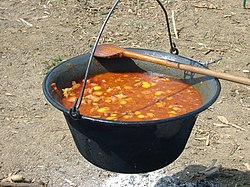Goulash

Gulyás in a traditional "bogrács"
|
|
| Type | Soup or stew |
|---|---|
| Place of origin | Hungary |
| Main ingredients | Meat, noodles, vegetables (especially potatoes), paprika, spices |
| |
|
Goulash (Hungarian: gulyás [ˈɡujaːʃ]) is a soup or stew of meat and vegetables, seasoned with paprika and other spices. Originating from the medieval Kingdom of Hungary, goulash is also a popular meal in Central Europe, Eastern Europe, the Netherlands, Belgium, Switzerland, Scandinavia and Southern Europe.
Its origin traces back to the 9th century to stews eaten by Hungarian shepherds. Back then, the cooked and flavored meat was dried with the help of the sun and packed into bags produced from sheep's stomachs, needing only water to make it into a meal. It is one of the national dishes of Hungary and a symbol of the country.
The name originates from the Hungarian "gulyás" [ˈɡujaːʃ]. The word "gulya" means "herd of cattle" in Hungarian, and "gulyás" means "herdsman" or "cowboy".
The word gulyás originally meant only "herdsman", but over time the dish became gulyáshús (goulash meat) – that is to say, a meat dish which was prepared by herdsmen. Today, gulyás refers both to the herdsmen, and to the soup. From the Middle Ages until well into the 19th century, the Puszta was the home of massive herds of cattle. They were driven, in their tens of thousands, to Europe’s biggest cattle markets in Moravia, Vienna, Nuremberg and Venice. The herdsmen made sure that there were always some cattle that had to be slaughtered along the way, the flesh of which provided them with gulyáshús.
...
Wikipedia
